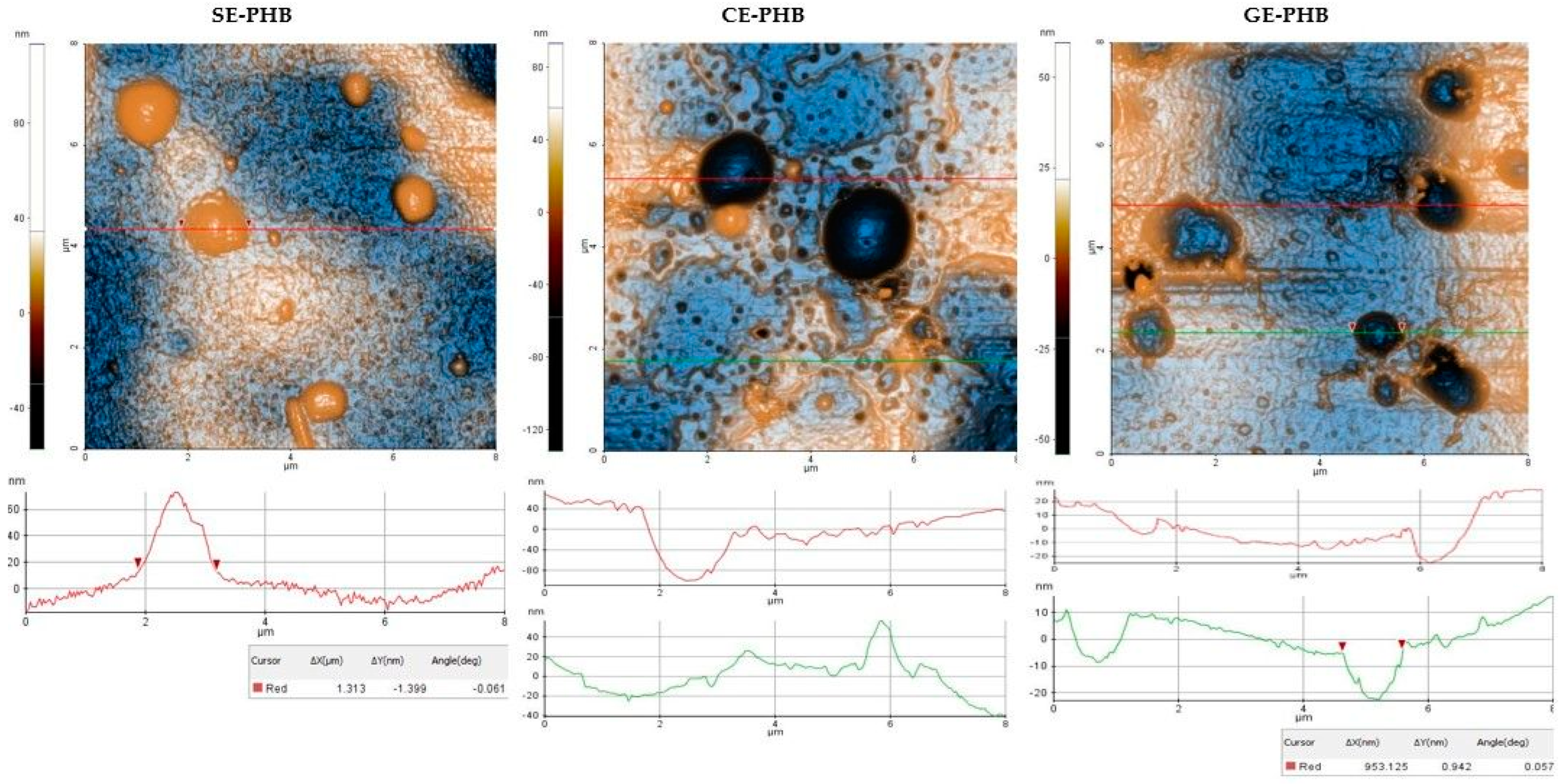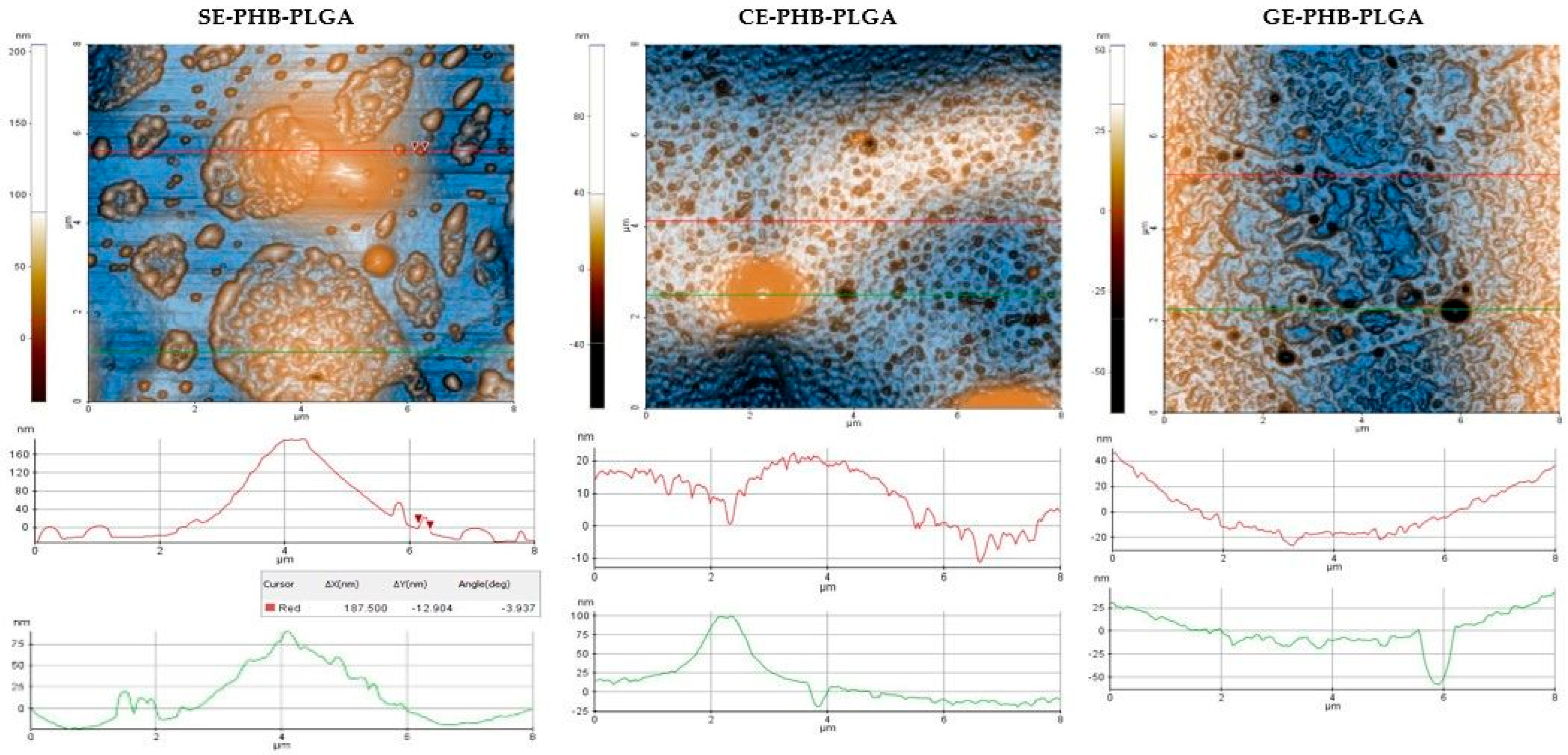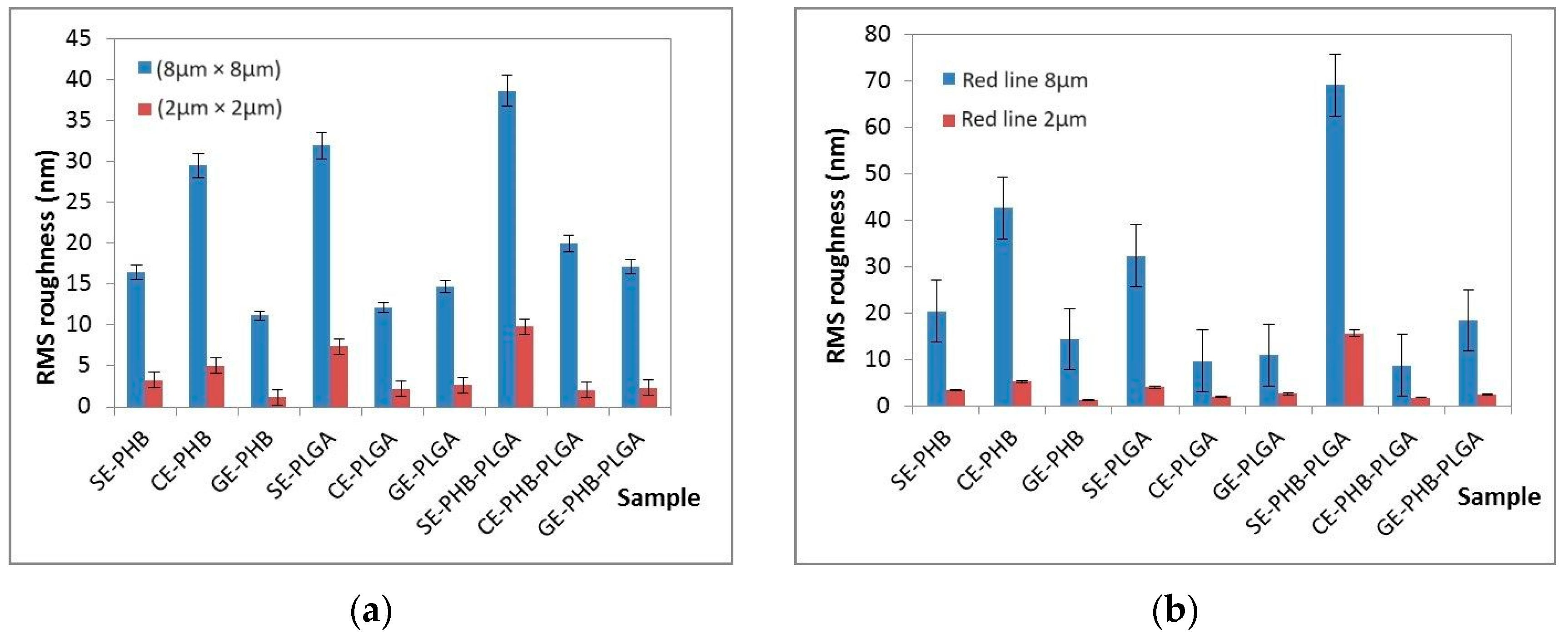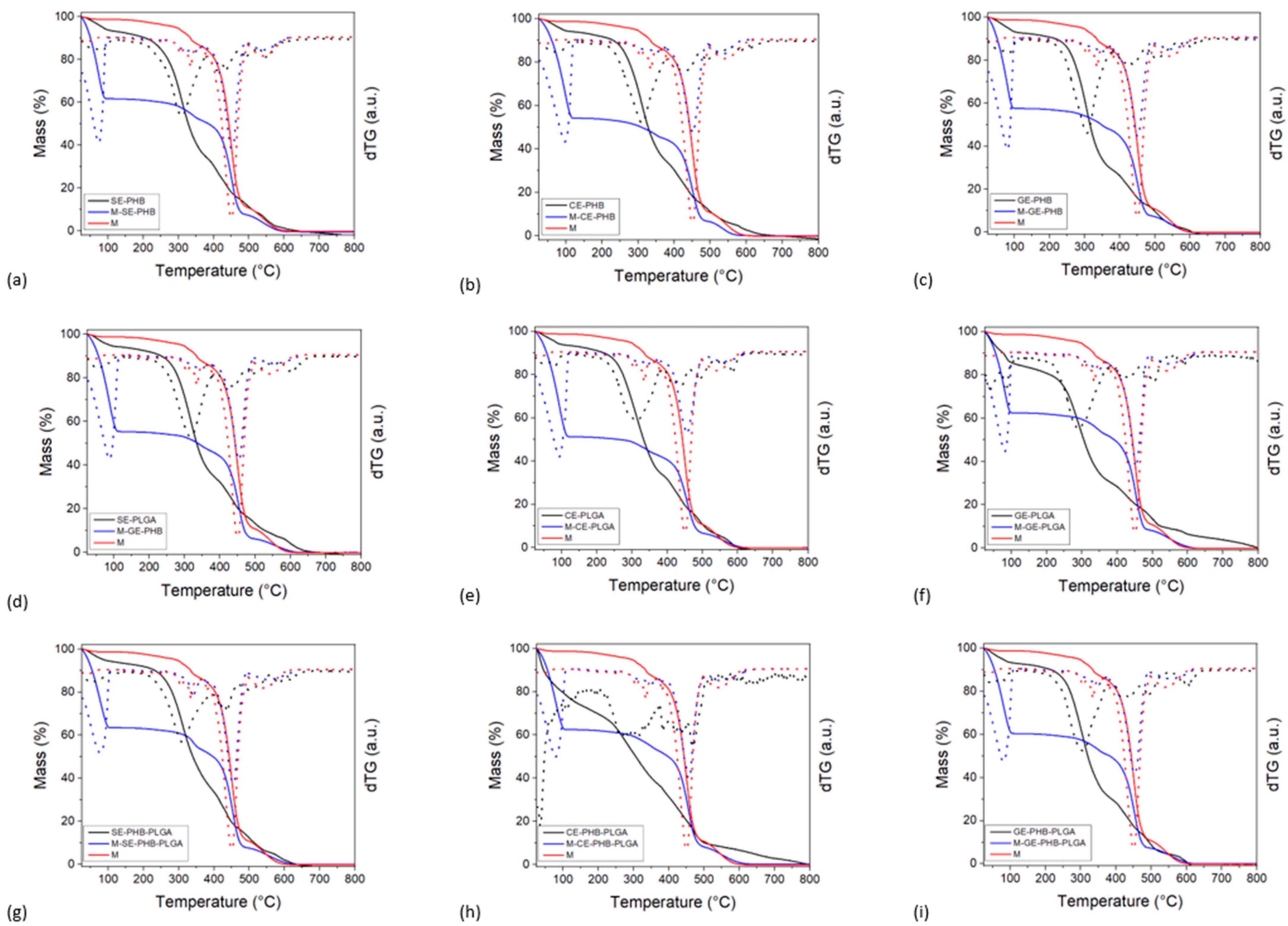Preparation and Preliminary Analysis of Several Nanoformulations Based on Plant Extracts and Biodegradable Polymers as a Possible Application for Chronic Venous Disease Therapy
Abstract
:1. Introduction
2. Materials and Methods
2.1. Preparation and pH Determination
2.2. Spreadability Measurement
2.3. Attenuated Total Reflectance Fourier Transform Infrared Spectroscopy (ATR-FTIR) Analysis
2.4. X-ray Diffractometry (XRD)
2.5. Atomic Force Microscopy (AFM)
2.6. Thermogravimetry
3. Results
3.1. Preparation and pH Determination
3.2. Spreadability Assay
3.3. Attenuated Total Reflectance Fourier Transform Infrared Spectroscopy (ATR-FTIR) Analysis
3.4. X-ray Diffractometry (XRD)
3.5. Atomic Force Microscopy (AFM)
3.6. Thermogravimetric Analysis
4. Discussion
5. Conclusions
Supplementary Materials
Author Contributions
Funding
Institutional Review Board Statement
Data Availability Statement
Conflicts of Interest
References
- Zorzi, G.K.; Carvalho, E.L.S.; von Poser, G.L.; Teixeira, H.F. On the use of nanotechnology-based strategies for association of complex matrices from plant extracts. Rev. Bras. Farmacogn. 2015, 25, 426–436. [Google Scholar] [CrossRef]
- Simon, S.; Sibuyi, N.R.S.; Fadaka, A.O.; Meyer, S.; Josephs, J.; Onani, M.O.; Meyer, M.; Madiehe, A.M. Biomedical Applications of Plant Extract-Synthesized Silver Nanoparticles. Biomedicines 2022, 10, 2792. [Google Scholar] [CrossRef] [PubMed]
- Cheng, Z.; Tang, S.; Feng, J.; Wu, Y. Biosynthesis and antibacterial activity of silver nanoparticles using Flos Sophorae Immaturus extract. Heliyon 2022, 8, e10010. [Google Scholar] [CrossRef] [PubMed]
- Ajazuddin, S.S. Applications of novel drug delivery system for herbal formulations. Fitoterapia 2010, 81, 680–689. [Google Scholar] [CrossRef] [PubMed]
- Moradi, S.Z.; Momtaz, S.; Bayrami, Z.; Farzaei, M.H.; Abdollahi, M. Nanoformulations of Herbal Extracts in Treatment of Neurodegenerative Disorders. Front. Bioeng. Biotechnol. 2020, 8, 238. [Google Scholar] [CrossRef] [PubMed]
- Das, M.K.; Kalita, B. Phytosome: An Overview. J. Pharm. Sci. Innov. 2013, 2, 7–11. [Google Scholar] [CrossRef]
- Gibis, M.; Zeeb, B.; Weiss, J. Formation, characterization, and stability of encapsulated hibiscus extract in multilayered liposomes. Food Hydrocoll. 2014, 38, 28–39. [Google Scholar] [CrossRef]
- Khogta, S.; Patel, J.; Barve, K.; Londhe, V. Herbal nano-formulations for topical delivery. J. Herb. Med. 2020, 20, 100300. [Google Scholar] [CrossRef]
- Nagula, R.L.; Wairkar, S. Recent advances in topical delivery of flavonoids: A review. J. Control. Release 2019, 296, 190–201. [Google Scholar] [CrossRef]
- Carter, P.; Narasimhan, B.; Wang, Q. Biocompatible nanoparticles and vesicular systems in transdermal drug delivery for various skin diseases. Int. J. Pharm. 2019, 555, 49–62. [Google Scholar] [CrossRef]
- Sala, M.; Diab, R.; Elaissari, A.; Fessi, H. Lipid nanocarriers as skin drug delivery systems: Properties, mechanisms of skin interactions and medical applications. Int. J. Pharm. 2018, 535, 1–17. [Google Scholar] [CrossRef] [PubMed]
- De Maeseneer, M.G.; Kakkos, S.K.; Aherne, T.; Baekgaard, N.; Black, S.; Blomgren, L.; Giannoukas, A.; Gohel, M.; de Graaf, R.; Hamel-Desnos, C.; et al. Editor’s Choice—European Society for Vascular Surgery (ESVS) 2022 Clinical Practice Guidelines on the Management of Chronic Venous Disease of the Lower Limbs. Eur. J. Vasc. Endovasc. Surg. 2022, 63, 184–267. [Google Scholar] [CrossRef] [PubMed]
- Wittens, C.; Davies, A.H.; Bækgaard, N.; Broholm, R.; Cavezzi, A.; Chastanet, S.; de Wolf, M.; Eggen, C.; Giannoukas, A.; Gohel, M.; et al. Editor’s Choice—Management of Chronic Venous Disease. Eur. J. Vasc. Endovasc. Surg. 2015, 49, 678–737. [Google Scholar] [CrossRef]
- Gloviczki, P.; Lawrence, P.F.; Wasan, S.M.; Meissner, M.H.; Almeida, J.; Brown, K.R.; Bush, R.L.; Di Iorio, M.; Fish, J.; Fukaya, E.; et al. The 2023 Society for Vascular Surgery, American Venous Forum, and American Vein and Lymphatic Society clinical practice guidelines for the management of varicose veins of the lower extremities. Part II. J. Vasc. Surg. Venous Lymphat. Disord. 2024, 12, 101670. [Google Scholar] [CrossRef] [PubMed]
- Lurie, F.; Branisteanu, D.E. Improving Chronic Venous Disease Management with Micronised Purified Flavonoid Fraction: New Evidence from Clinical Trials to Real Life. Clin. Drug Investig. 2023, 43, 9–13. [Google Scholar] [CrossRef] [PubMed]
- Ungureanu, A.R.; Chițescu, C.L.; Luță, E.A.; Moroșan, A.; Mihaiescu, D.E.; Mihai, D.P.; Costea, L.; Ozon, E.A.; Fița, A.C.; Balaci, T.D.; et al. Outlook on Chronic Venous Disease Treatment: Phytochemical Screening, In Vitro Antioxidant Activity and In Silico Studies for Three Vegetal Extracts. Molecules 2023, 28, 3668. [Google Scholar] [CrossRef] [PubMed]
- Ulloa, J.H. Optimising Decision Making in Chronic Venous Disease Management with Micronised Purified Flavonoid Fraction. Clin. Drug Investig. 2023, 43, 15–19. [Google Scholar] [CrossRef] [PubMed]
- Casili, G.; Lanza, M.; Campolo, M.; Messina, S.; Scuderi, S.; Ardizzone, A.; Filippone, A.; Paterniti, I.; Cuzzocrea, S.; Esposito, E. Therapeutic potential of flavonoids in the treatment of chronic venous insufficiency. Vasc. Pharmacol. 2021, 137, 106825. [Google Scholar] [CrossRef]
- Wang, J.; Feng, X.; Li, Z.; Liu, Y.; Yang, W.; Zhang, T.; Guo, P.; Liu, Z.; Qi, D.; Pi, J. The Flavonoid Components of Scutellaria baicalensis: Biopharmaceutical Properties and their Improvement using Nanoformulation Techniques. Curr. Top. Med. Chem. 2023, 23, 17–29. [Google Scholar] [CrossRef]
- Ravetti, S.; Garro, A.G.; Gaitán, A.; Murature, M.; Galiano, M.; Brignone, S.G.; Palma, S.D. Naringin: Nanotechnological Strategies for Potential Pharmaceutical Applications. Pharmaceutics 2023, 15, 863. [Google Scholar] [CrossRef]
- Patton, D.; Avsar, P.; Sayeh, A.; Budri, A.; O’Connor, T.; Walsh, S.; Nugent, L.; Harkin, D.; O’Brien, N.; Cayce, J.; et al. A meta-review of the impact of compression therapy on venous leg ulcer healing. Int. Wound J. 2023, 20, 430–447. [Google Scholar] [CrossRef] [PubMed]
- Buzzi, M.; de Freitas, F.; de Barros Winter, M. Therapeutic effectiveness of a Calendula officinalis extract in venous leg ulcer healing. J. Wound Care 2016, 25, 732–739. [Google Scholar] [CrossRef] [PubMed]
- Chen, K.; Sun, W.; Jiang, Y.; Chen, B.; Zhao, Y.; Sun, J.; Gong, H.; Qi, R. Ginkgolide B Suppresses TLR4-Mediated Inflammatory Response by Inhibiting the Phosphorylation of JAK2/STAT3 and p38 MAPK in High Glucose-Treated HUVECs. Oxid. Med. Cell Longev. 2017, 2017, 9371602. [Google Scholar] [CrossRef]
- Lee, S.Y.; Kim, S.Y.; Ku, S.H.; Park, E.J.; Jang, D.J.; Kim, S.T.; Kim, S.B. Polyhydroxyalkanoate Decelerates the Release of Paclitaxel from Poly(lactic-co-glycolic acid) Nanoparticles. Pharmaceutics 2022, 14, 1618. [Google Scholar] [CrossRef] [PubMed]
- Negahdari, R.; Bohlouli, S.; Sharifi, S.; Maleki Dizaj, S.; Rahbar Saadat, Y.; Khezri, K.; Jafari, S.; Ahmadian, E.; Gorbani Jahandizi, N.; Raeesi, S. Therapeutic benefits of rutin and its nanoformulations. Phytother. Res. 2021, 35, 1719–1738. [Google Scholar] [CrossRef] [PubMed]
- Vu, H.T.H.; Streck, S.; Hook, S.M.; McDowell, A. Utilization of Microfluidics for the Preparation of Polymeric Nanoparticles for the Antioxidant Rutin: A Comparison with Bulk Production. Pharm. Nanotechnol. 2019, 7, 469–483. [Google Scholar] [CrossRef] [PubMed]
- Marouf, N.; Nojehdehian, H.; Ghorbani, F. Physicochemical properties of chitosan–hydroxyapatite matrix incorporated with Ginkgo biloba-loaded PLGA microspheres for tissue engineering applications. Polym. Polym. Compos. 2020, 28, 320–330. [Google Scholar] [CrossRef]
- Arana, L.; Salado, C.; Vega, S.; Aizpurua-Olaizola, O.; de la Arada, I.; Suarez, T.; Usobiaga, A.; Arrondo, J.L.R.; Alonso, A.; Goñi, F.M.; et al. Solid lipid nanoparticles for delivery of Calendula officinalis extract. Colloids Surf. B Biointerfaces 2015, 135, 18–26. [Google Scholar] [CrossRef]
- International Council for Harmonisation of Technical Requirements for Pharmaceuticals for Huma Use. ICH Guideline Q3C (R8) on Impurities: Guideline for Residual Solvents. November 2022. Available online: https://database.ich.org/sites/default/files/ICH_Q3C-R8_Guideline_Step4_2021_0422_1.pdf (accessed on 29 April 2024).
- Rincón, M.; Silva-Abreu, M.; Espinoza, L.C.; Sosa, L.; Calpena, A.C.; Rodríguez-Lagunas, M.J.; Colom, H. Enhanced Transdermal Delivery of Pranoprofen Using a Thermo-Reversible Hydrogel Loaded with Lipid Nanocarriers for the Treatment of Local Inflammation. Pharmaceuticals 2021, 15, 22. [Google Scholar] [CrossRef]
- Nandiyanto, A.B.D.; Oktiani, R.; Ragadhita, R. How to Read and Interpret FTIR Spectroscope of Organic Material. Indones. J. Sci. Technol. 2019, 4, 97. [Google Scholar] [CrossRef]
- Musuc, A.M.; Anuta, V.; Atkinson, I.; Sarbu, I.; Popa, V.T.; Munteanu, C.; Mircioiu, C.; Ozon, E.A.; Nitulescu, G.M.; Mitu, M.A. Formulation of Chewable Tablets Containing Carbamazepine-β-cyclodextrin Inclusion Complex and F-Melt Disintegration Excipient. The Mathematical Modeling of the Release Kinetics of Carbamazepine. Pharmaceutics 2021, 13, 915. [Google Scholar] [CrossRef] [PubMed]
- Barbălată-Mândru, M.; Serbezeanu, D.; Butnaru, M.; Rîmbu, C.M.; Enache, A.A.; Aflori, M. Poly(vinyl alcohol)/Plant Extracts Films: Preparation, Surface Characterization and Antibacterial Studies against Gram Positive and Gram Negative Bacteria. Materials 2022, 15, 2493. [Google Scholar] [CrossRef] [PubMed]
- Musuc, A.M.; Badea-Doni, M.; Jecu, L.; Rusu, A.; Popa, V.T. FTIR, XRD, and DSC analysis of the rosemary extract effect on polyethylene structure and biodegradability. J. Therm. Anal. Calorim. 2013, 114, 169–177. [Google Scholar] [CrossRef]
- McDonough, M.; Perov, P.; Johnson, W.; Radojev, S. Data Processing & Analysis for Atomic Force Microscopy (AFM). 2020. Available online: https://dc.suffolk.edu/undergrad/18 (accessed on 10 February 2024).
- Popovici, V.; Matei, E.; Cozaru, G.C.; Bucur, L.; Gîrd, C.E.; Schröder, V.; Ozon, E.A.; Musuc, A.M.; Mitu, M.A.; Atkinson, I.; et al. In Vitro Anticancer Activity of Mucoadhesive Oral Films Loaded with Usnea barbata (L.) F. H. Wigg Dry Acetone Extract, with Potential Applications in Oral Squamous Cell Carcinoma Complementary Therapy. Antioxidants 2022, 11, 1934. [Google Scholar] [CrossRef] [PubMed]
- Popovici, V.; Matei, E.; Cozaru, G.C.; Bucur, L.; Gîrd, C.E.; Schröder, V.; Ozon, E.A.; Mitu, M.A.; Musuc, A.M.; Petrescu, S.; et al. Design, Characterization, and Anticancer and Antimicrobial Activities of Mucoadhesive Oral Patches Loaded with Usnea barbata (L.) F. H. Wigg Ethanol Extract F-UBE-HPMC. Antioxidants 2022, 11, 1801. [Google Scholar] [CrossRef] [PubMed]
- Chelu, M.; Popa, M.; Ozon, E.A.; Pandele Cusu, J.; Anastasescu, M.; Surdu, V.A.; Calderon Moreno, J.; Musuc, A.M. High-Content Aloe vera Based Hydrogels: Physicochemical and Pharmaceutical Properties. Polymers 2023, 15, 1312. [Google Scholar] [CrossRef]
- Popovici, V.; Matei, E.; Cozaru, G.C.; Bucur, L.; Gîrd, C.E.; Schröder, V.; Ozon, E.A.; Sarbu, I.; Musuc, A.M.; Atkinson, I.; et al. Formulation and Development of Bioadhesive Oral Films Containing Usnea barbata (L.) F.H.Wigg Dry Ethanol Extract (F-UBE-HPC) with Antimicrobial and Anticancer Properties for Potential Use in Oral Cancer Complementary Therapy. Pharmaceutics 2022, 14, 1808. [Google Scholar] [CrossRef]
- Yeo, J.C.C.; Muiruri, J.K.; Tan, B.H.; Thitsartarn, W.; Kong, J.; Zhang, X.; Li, Z.; He, C. Biodegradable PHB-Rubber Copolymer Toughened PLA Green Composites with Ultrahigh Extensibility. ACS Sustain. Chem. Eng. 2018, 6, 15517–15527. [Google Scholar] [CrossRef]
- Kurusu, R.S.; Siliki, C.A.; David, É.; Demarquette, N.R.; Gauthier, C.; Chenal, J.M. Incorporation of plasticizers in sugarcane-based poly(3-hydroxybutyrate)(PHB): Changes in microstructure and properties through ageing and annealing. Ind. Crop. Prod. 2015, 72, 166–174. [Google Scholar] [CrossRef]
- Cerruti, P.; Santagata, G.; Gomez d’Ayala, G.; Ambrogi, V.; Carfagna, C.; Malinconico, M.; Persico, P. Effect of a natural polyphenolic extract on the properties of a biodegradable starch-based polymer. Polym. Degrad. Stab. 2011, 96, 839–846. [Google Scholar] [CrossRef]
- Fan, Z.; Sun, J.; Yang, X.; Du, J.; Miao, Y.; Dong, H.; Wang, H. Influence of steric configurations in the conjugated polymers using acridine-triazine derivates as green chromophores. Synth. Met. 2024, 301, 117531. [Google Scholar] [CrossRef]
- Bennet, D.; Kim, S. A Transdermal Delivery System to Enhance Quercetin Nanoparticle Permeability. J. Biomater. Sci. Polym. Ed. 2013, 24, 185–209. [Google Scholar] [CrossRef] [PubMed]
- Pool, H.; Quintanar, D.; de Dios Figueroa, J.; Marinho Mano, C.; Bechara, J.E.H.; Godínez, L.A.; Mendoza, S. Antioxidant Effects of Quercetin and Catechin Encapsulated into PLGA Nanoparticles. J. Nanomater. 2012, 2012, 145380. [Google Scholar] [CrossRef]
- Vilchez, A.; Acevedo, F.; Cea, M.; Seeger, M.; Navia, R. Development and thermochemical characterization of an antioxidant material based on polyhydroxybutyrate electrospun microfibers. Int. J. Biol. Macromol. 2021, 183, 772–780. [Google Scholar] [CrossRef]
- Han, L.; Fu, Y.; Cole, A.J.; Liu, J.; Wang, J. Co-encapsulation and sustained-release of four components in ginkgo terpenes from injectable PELGE nanoparticles. Fitoterapia 2012, 83, 721–731. [Google Scholar] [CrossRef]
- Saleh, A.; Abdelkader, D.H.; El-Masry, T.A.; Eliwa, D.; Alotaibi, B.; Negm, W.A.; Elekhnawy, E. Antiviral and antibacterial potential of electrosprayed PVA/PLGA nanoparticles loaded with chlorogenic acid for the management of coronavirus and Pseudomonas aeruginosa lung infection. Artif. Cells Nanomed. Biotechnol. 2023, 51, 255–267. [Google Scholar] [CrossRef]
- Bruun, S.W.; Kohler, A.; Adt, I.; Sockalingum, G.D.; Manfait, M.; Martens, H. Correcting Attenuated Total Reflection—Fourier Transform Infrared Spectra for Water Vapor and Carbon Dioxide. Appl. Spectrosc. 2006, 60, 1029–1039. [Google Scholar] [CrossRef] [PubMed]
- Topala, C.M.; Tătaru, L.D.; Ducu, C. ATR-FTIR Spectra Fingerprinting of Medicinal Herbs Extracts Prepared Using Microwave Extraction. Arab. J. Med. Aromat. Plants 2017, 3, 1–9. [Google Scholar] [CrossRef]
- Abidin, A.Z.; Bakar, N.H.H.A.; Bakar, M.A. Studies on the properties of natural rubber/poly-3-hydroxybutyrate blends prepared by sol-vent casting. Malays. J. Anal. Sci. 2021, 25, 40–52. Available online: https://mjas.analis.com.my/mjas/v25_n1/pdf/Asmaa_25_1_4.pdf (accessed on 10 February 2024).
- Gentile, P.; Chiono, V.; Carmagnola, I.; Hatton, P. An Overview of Poly(lactic-co-glycolic) Acid (PLGA)-Based Biomaterials for Bone Tissue Engineering. Int. J. Mol. Sci. 2014, 15, 3640–3659. [Google Scholar] [CrossRef]
- Blasi, P. Poly(lactic acid)/poly(lactic-co-glycolic acid)-based microparticles: An overview. J. Pharm. Investig. 2019, 49, 337–346. [Google Scholar] [CrossRef]
- Jog, R.; Burgess, D.J. Pharmaceutical Amorphous Nanoparticles. J. Pharm. Sci. 2017, 106, 39–65. [Google Scholar] [CrossRef] [PubMed]
- Venkatraman, P.D.; Sayed, U.; Parte, S.; Korgaonkar, S. Development of Advanced Textile Finishes Using Nano-Emulsions from Herbal Extracts for Organic Cotton Fabrics. Coatings 2021, 11, 939. [Google Scholar] [CrossRef]
- Gotmare, V.D.; Kole, S.S.; Athawale, R.B. Sustainable approach for development of antimicrobial textile material using nanoemulsion for wound care applications. Fash. Text. 2018, 5, 25. [Google Scholar] [CrossRef]
- Kole, S.S.; Gotmare, V.D.; Athawale, R.B. Novel approach for development of eco-friendly antimicrobial textile material for health care application. J. Text. Inst. 2019, 110, 254–266. [Google Scholar] [CrossRef]
- Das, M.K.; Kalita, B. Design and Evaluation of Phyto-Phospholipid Complexes (Phytosomes) of Rutin for Transdermal Application. J. Appl. Pharm. Sci. 2014, 4, 51–57. [Google Scholar] [CrossRef]
- Cândido, T.M.; De Oliveira, C.A.; Ariede, M.B.; Velasco, M.V.R.; Rosado, C.; Baby, A.R. Safety and Antioxidant Efficacy Profiles of Rutin-Loaded Ethosomes for Topical Application. AAPS PharmSciTech 2018, 19, 1773–1780. [Google Scholar] [CrossRef] [PubMed]
- Park, S.N.; Lee, H.J.; Gu, H.A. Enhanced skin delivery and characterization of rutin-loaded ethosomes. Korean J. Chem. Eng. 2014, 31, 485–489. [Google Scholar] [CrossRef]
- Bilia, A.R.; Bergonzi, M.C.; Guccione, C.; Manconi, M.; Fadda, A.M.; Sinico, C. Vesicles and micelles: Two versatile vectors for the delivery of natural products. J. Drug Deliv. Sci. Technol. 2016, 32, 241–255. [Google Scholar] [CrossRef]








| Weight (g) | |||||||
|---|---|---|---|---|---|---|---|
| 150 | 250 | 350 | 450 | 550 | 650 | 750 | |
| Sample | The Spreading Surface * (cm2) | ||||||
| SE-PHB | 58.54 ± 3.22 | 92.18 ± 5.17 | 102.13 ± 8.25 | 110.56 ± 3.89 | 114.31 ± 2.19 | 116.84 ± 1.92 | 117.49 ± 2.21 |
| CE-PHB | 59.99 ± 6.40 | 99.11 ± 5.37 | 109.97 ± 5.56 | 125.34 ± 6.04 | 136.85 ± 7.51 | 141.00 ± 6.31 | 141.72 ± 7.24 |
| GE-PHB | 56.28 ± 2.02 | 91.79 ± 11.04 | 108.10 ± 4.65 | 121.36 ± 2.99 | 130.64 ± 2.03 | 136.78 ± 2.07 | 137.48 ± 2.39 |
| SE-PLGA | 42.61 ± 1.76 | 47.76 ± 1.22 | 55.41 ± 2.30 | 61.73 ± 2.12 | 67.93 ± 3.89 | 70.36 ± 1.72 | 73.36 ± 0.87 |
| CE-PLGA | 54.54 ± 2.71 | 73.93 ± 5.53 | 82.81 ± 5.65 | 91.58 ± 3.39 | 99.70 ± 5.64 | 105.69 ± 6.25 | 109.34 ± 4.87 |
| GE-PLGA | 59.44 ± 2.73 | 69.90 ± 4.50 | 78.52 ± 3.14 | 86.06 ± 5.76 | 95.68 ± 8.11 | 103.93 ± 8.22 | 105.16 ± 9.24 |
| SE-PHB-PLGA | 51.52 ± 2.54 | 59.88 ± 1.58 | 68.39 ± 2.24 | 75.40 ± 1.54 | 82.23 ± 3.33 | 88.27 ± 5.96 | 92.70 ± 0.98 |
| CE-PHB-PLGA | 63.60 ± 2.46 | 87.11 ± 2.53 | 93.85 ± 2.63 | 103.23 ± 2.74 | 108.70 ± 2.82 | 116.23 ± 4.80 | 117.50 ± 3.98 |
| GE-PHB-PLGA | 52.38 ± 2.68 | 70.36 ± 1.72 | 81.15 ± 2.43 | 87.66 ± 2.53 | 95.57 ± 2.65 | 99.07 ± 2.70 | 100.86 ± 4.49 |
| Area | Whole Surface | Red Line Profile | ||||||||||
|---|---|---|---|---|---|---|---|---|---|---|---|---|
| Scale | 8 × 8 μm2 | 2 × 2 μm2 | 8 μm2 | 2 μm2 | ||||||||
| Parameter (nm) | Rpv | Rq | Ra | Rpv | Rq | Ra | Rpv | Rq | Ra | Rpv | Rq | Ra |
| SE-PHB | 170.768 | 16.443 | 11.744 | 27.010 | 3.286 | 2.585 | 91.065 | 20.301 | 13.954 | 18.289 | 3.395 | 2.765 |
| CE-PHB | 224.990 | 29.470 | 21.029 | 46.588 | 5.047 | 3.955 | 166.909 | 42.605 | 32.942 | 23.874 | 5.161 | 4.394 |
| GE-PHB | 113.708 | 11.175 | 8.689 | 10.901 | 1.155 | 0.943 | 53.389 | 14.300 | 11.886 | 5.201 | 1.152 | 0.869 |
| Area | Whole Surface | Red Line Profile | ||||||||||
|---|---|---|---|---|---|---|---|---|---|---|---|---|
| Scale | 8 × 8 μm2 | 2 × 2 μm2 | 8 μm2 | 2 μm2 | ||||||||
| Parameter (nm) | Rpv | Rq | Ra | Rpv | Rq | Ra | Rpv | Rq | Ra | Rpv | Rq | Ra |
| SE-PLGA | 166.137 | 31.919 | 27.101 | 45.421 | 7.394 | 5.963 | 124.934 | 32.250 | 27.486 | 14.222 | 3.948 | 3.333 |
| CE-PLGA | 175.082 | 12.202 | 8.726 | 19.523 | 2.184 | 1.710 | 61.694 | 9.614 | 6.917 | 9.820 | 1.837 | 1.442 |
| GE-PLGA | 94.713 | 14.761 | 10.703 | 18.334 | 2.633 | 2.125 | 42.459 | 10.898 | 9.441 | 11.738 | 2.506 | 1.931 |
| Area | Whole Surface | Red Line Profile | ||||||||||
|---|---|---|---|---|---|---|---|---|---|---|---|---|
| Scale | 8 × 8 μm2 | 2 × 2 μm2 | 8 μm2 | 2 μm2 | ||||||||
| Parameter (nm) | Rpv | Rq | Ra | Rpv | Rq | Ra | Rpv | Rq | Ra | Rpv | Rq | Ra |
| SE-PHB-PLGA | 249.559 | 38.634 | 27.655 | 86.305 | 9.802 | 7.801 | 226.326 | 68.959 | 57.453 | 81.669 | 15.593 | 11.810 |
| CE-PHB-PLGA | 191.320 | 19.981 | 15.339 | 19.386 | 2.055 | 1.568 | 33.433 | 8.625 | 7.514 | 8.011 | 1.767 | 1.421 |
| GE-PHB-PLGA | 114.624 | 17.087 | 14.496 | 30.014 | 2.359 | 1.807 | 72.339 | 18.340 | 15.774 | 9.472 | 2.307 | 1.967 |
| Sample | Formulation (%wt.) | Matrix (%wt.) |
|---|---|---|
| M-SE-PHB | 7.8 | 92.2 |
| M-CE-PHB | 9.5 | 90.5 |
| M-GE-PHB | 7.0 | 93.0 |
| M-SE-PLGA | 5.4 | 94.6 |
| M-CE-PLGA | 8.1 | 91.9 |
| M-GE-PLGA | 5.2 | 94.8 |
| M-SE-PHB-PLGA | 8.5 | 91.5 |
| M-CE-PHB-PLGA | 6.7 | 93.3 |
| M-GE-PHB-PLGA | 4.9 | 95.1 |
Disclaimer/Publisher’s Note: The statements, opinions and data contained in all publications are solely those of the individual author(s) and contributor(s) and not of MDPI and/or the editor(s). MDPI and/or the editor(s) disclaim responsibility for any injury to people or property resulting from any ideas, methods, instructions or products referred to in the content. |
© 2024 by the authors. Licensee MDPI, Basel, Switzerland. This article is an open access article distributed under the terms and conditions of the Creative Commons Attribution (CC BY) license (https://creativecommons.org/licenses/by/4.0/).
Share and Cite
Ungureanu, A.R.; Ozon, E.A.; Musuc, A.M.; Anastasescu, M.; Atkinson, I.; Mitran, R.-A.; Rusu, A.; Popescu, L.; Gîrd, C.E. Preparation and Preliminary Analysis of Several Nanoformulations Based on Plant Extracts and Biodegradable Polymers as a Possible Application for Chronic Venous Disease Therapy. Polymers 2024, 16, 1362. https://doi.org/10.3390/polym16101362
Ungureanu AR, Ozon EA, Musuc AM, Anastasescu M, Atkinson I, Mitran R-A, Rusu A, Popescu L, Gîrd CE. Preparation and Preliminary Analysis of Several Nanoformulations Based on Plant Extracts and Biodegradable Polymers as a Possible Application for Chronic Venous Disease Therapy. Polymers. 2024; 16(10):1362. https://doi.org/10.3390/polym16101362
Chicago/Turabian StyleUngureanu, Andreea Roxana, Emma Adriana Ozon, Adina Magdalena Musuc, Mihai Anastasescu, Irina Atkinson, Raul-Augustin Mitran, Adriana Rusu, Liliana Popescu, and Cerasela Elena Gîrd. 2024. "Preparation and Preliminary Analysis of Several Nanoformulations Based on Plant Extracts and Biodegradable Polymers as a Possible Application for Chronic Venous Disease Therapy" Polymers 16, no. 10: 1362. https://doi.org/10.3390/polym16101362







